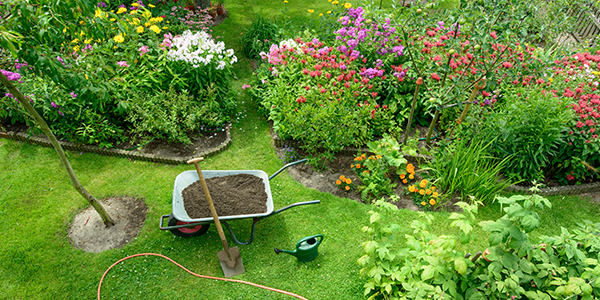Island garden beds can be a beautiful addition to any yard that adds color and texture. With simple materials like garden edging stakes, mulch, perennials, and annuals, you can design an island bed that will compliment your lawn throughout the entire year.
Planning and Designing an Island Garden Bed
Island garden beds are an opportunity to be creative and take risks in your yard. First, you want to assess the best spot to place your island bed and its size. Avoid any areas with heavy foot traffic and choose a location that will compliment your space. The bed's size should be large enough to fit all the plants, bushes, or trees that you plan to install. Additionally, the size of the bed should be to scale of your yard and home.
After you assess all these elements, draw out the shape you plan to use. Trace the shape onto the ground using stakes to delineate your island bed. Use twine around the stakes to establish the shape and modify as needed. Once you have designed a shape you are happy with, you will need to dig out the grass within the perimeter. At this point, you should add edging of your choice. Steel edging placed with landscape edging stakes is a long-term solution that will not be affected by rain or frost.
Creating Layers in Your Bed and Choosing the Right Soil
Selecting plants for your island bed can truly be a creative process. You want to consider the bed as an opportunity to layers plants both in height, color, and function. As far as height, you want to include tall accent plants such as small trees toward the center of the bed to create dimension and medium-sized to small shrubs and ground covers in the surrounded area. The smallest plants should fill any gaps and cover the outside perimeter of the bed. As far as color, you want to consider perennials, annuals, and evergreen varieties to keep your island bed lively during every season.
Depending on what plants or theme you decide on, you may need to create an optimal soil mixture for the plants to thrive. If you decide to go with an edible food garden bed with herbs, small fruiting trees, and vegetables, you will need to add a mixture of compost, peat moss, and topsoil to promote growth. For flowering plants, layering topsoil along with fertilizers during the spring can yield larger blooms.
Maintaining Island Garden Beds
Another thing to consider when choosing what plants to add to your island includes how often they need to be maintained and if you need to add walking space to get to those particular plants. If you want any island bed that needs little to no maintenance, consider adding more resilient shrubs and trees that require less pruning, like evergreens or forsythia. In order to maintain the aesthetic appeal of your island bed, you should consider adding boulders and ornamental fixtures such as a birdbath. A recommended finishing touch would be adding a layer of premium mulch such as a triple shredded black mulch. Using a darker mulch will add depth and dimension to your space. The mulch will also serve as a weed barrier while also degrading slowly over time and adding nitrogen back to the soil. You should add a fresh layer every year.
Overall, designing an island garden bed can be a creative and rewarding experience. It creates a focal point that can tie your space together and is visually appealing through every season if layered correctly. Kurtz Bros., Inc has all of the tools to help you design your garden including landscaping edging stakes, steel edging, premium topsoil, and triple shredded black mulch. Contact us or visit us in-store so we can assist you with your design.

